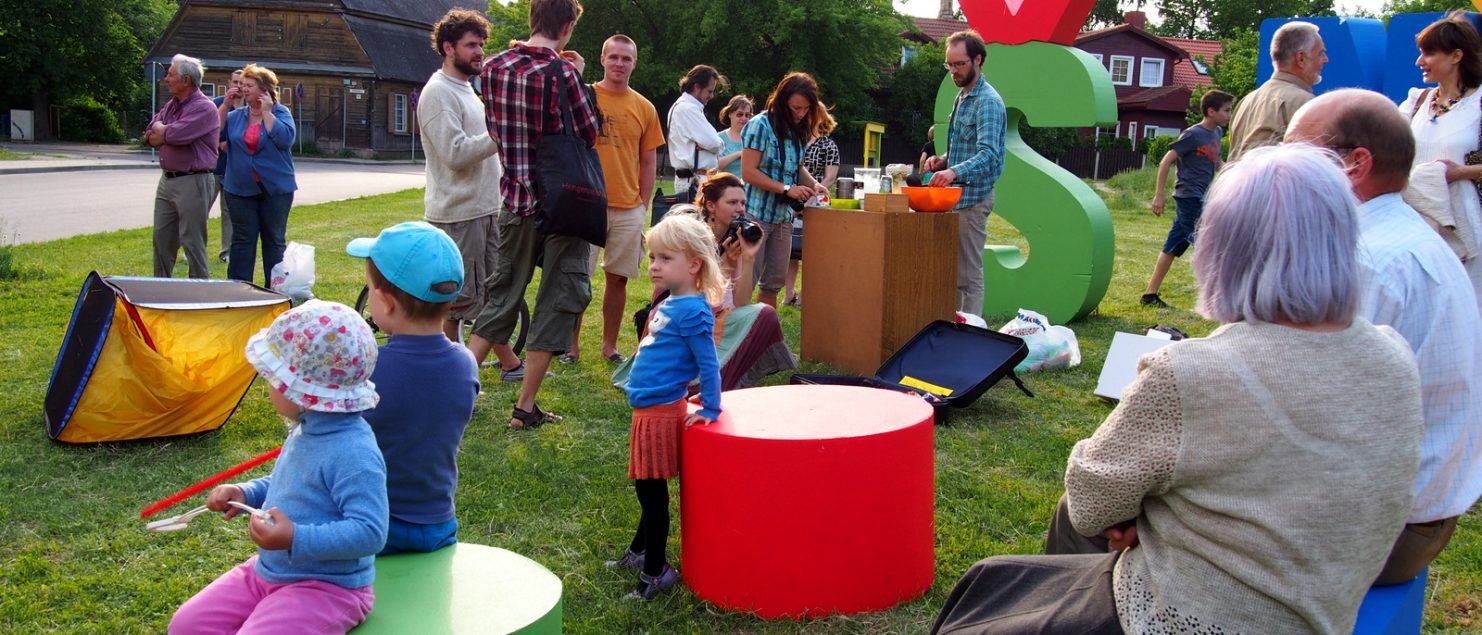Arts-based research and placemaking in Šnipiškės (timeline)
Our placemaking journey in the historic Šnipiškės neighbourhood started in 2012. The arts-based approach is our primary method, which means that we involve residents in cooperative actions during the research stage, seeking to contribute to the local well-being. We foster networks of mutual help by providing and administrating local communication tools, platforms and formats. We contribute to the vibrant public spaces and image of the place by arranging cultural events, art interventions, and co-design workshops. In Šnipiškės case, we needed to find the plots and co-design public spaces as there was no gathering place in the historic part of the district. We contribute to the new image of the place by co-creating new cultural routes, urban games and lunching excursions. Residents (Asta, Miroslavas, Artur and his son Kamilis, Emilis, Volkovs’ kids, Agnieška and others) contributed a lot. The process embraces the following stages:
Desk-research & field research » Creative communication and placemaking tools » Participatory design-based research » Cooperatively developed cultural routes, developed public space (Dragon’s field), adjusted image of the neighbourhood » Educational activities for visiting artists, researchers, students and other groups » Publications, exhibitions, interviews.
2012 – We studied the cultural potential (including mapping of the unique architectural elements, neighbourhood’s colour palette and other elements essential for the local identity), dominating image (media content analysis), social background (during the design-based research phase), and use of the wooden Šnipiškės territory – flows of people, points of attractions, and places for contact between inhabitants. We have identified the hot spots where the most social connections happen or may happen. We identified the plots that may become public spaces and contacted Šnipiškės leadership to get the permissions for future actions.
2013 – Laimikis team installed notice boards at the identified hot spots and renewed a neglected notice board on Fino Street. During this onsite activity, we made first contact with the local inhabitants. Laimikis and the inhabitants started using the notice boards, proposing various topics for consideration and discussion. Facebook group Šnipiškiečiai is launched. For several years after we installed notice boards, we ran parallel online and offline communication to include as many inhabitants as possible. In 2022, the installed board at the Dragon’s Field was renewed by the local artist Pijus.
• Drawing upon the findings during the desk research concerning the district’s history, the Street Mosaics Workshop was launched, and the mosaics route was developed in cooperation with the local inhabitants, especially local children.
• The first neighbours’ picnic was arranged in one of the identified potential public spaces. We have designed a module urban furniture set consisting of the letters “ŠNIPIŠKĖS” that could be used for representational purposes and as a placemaking set during community gatherings in public spaces.
• Because neighbours’ picnics have become regular, we proposed that inhabitants choose the name for the revitalised public space, and most of the preferences were for the name of the Dragon’s Field. Later, we had to defend this name at the municipality’s “memory commission”. Dragon’s field name was officially registered in municipal documents.
• Drawing on the results of mapping the elements and traits crucial to the identity of the district, in cooperation with the designer Tomas Umbrasas, a visual identity pack for Šnipiškės communication was created, used for the layouts of the notice boards, Facebook group, flyers and newsletters, and further installations in the public space.
•• As a part of the “InterContexts” network, our activities in Šnipiškės were acknowledged as the European Star project.
2014 – We created, tested and patented the urban game “Urbingo”, which promotes the districts’ local heritage – architecture and everyday culture. The very 1st version of the game was devoted to Šnipiškės wooden heritage. This game was created based on the photo archive of urban elements and panoramas, which are essential for the character of the historic area. Inhabitants contributed to the photo archive. Since then, Laimikis has arranged this game in Šnipiškės by request.
2014-2016 – Continued: neighbours picnics at the Dragons field, use of the placemaking set, Street Mosaics Workshop. Started: Jekaterina Lavrinec and Asta Nazarovienė start excursions to Šnipiškės. Asta knows many peculiar details about the area’s lifestyle as a local. We strongly support the idea that locals should run the excursions and benefit from the cultural activities in the historic neighbourhoods. Local narratives belong to the local people.
2015 – Continuing the placemaking program for the public spaces in the neighbourhood, Laimikis ran Co-design workshops in 4 Vilnius neighbourhoods (Šnipiškės among them), during which we created and tested another placemaking set, Tetris-like “Open code urban furniture“, in each participating neighbourhood. The co-design workshop is the outcome of the design-based research conducted by Jekaterina Lavrinec (CDC grant). Many thanks to Miroslavas, Asta, Artur and Kamilis for help, and we had many helpers among local kids who started arranging events for other resident groups :)
2016 – Because the attempt to establish the owners’ association failed with the inhabitants, we started developing a participatory economic model for the historic neighbourhood. We mapped the scenarios for using the property based on what the owners proposed (excursions, open-air cafes, workshops, souvenir shops). The whole neighbourhood can work as a spatial network of interconnected services. As a key speaker at the annual European Community Centres Forum, dr. Jekaterina Lavrinec presented the developed methodology and collected alternative models used in the UK, Germany and Spain (TEH83: Sharing Communities, ROJC, Pula, Croatia, 2017). It was also presented at a series of seminars in Brussels and Vilnius (including Urbact 2017).
• In cooperation with locals, Laimikis group applies to the Vilnius municipality to establish two public spaces in the neighbourhood (Dragon’s Field and the “Saracens’ pocket park” – the latter name is just a working version) and go through the process of including two public spaces in the planning documents. We are grateful for the “No Architects” consultancy!
2016-2018 – Laimikis cooperates with Vilnius University, Department of Geography and Land Management; prof. Dovilė Krupickaitė and dr. Jekaterina Lavrinec runs annual field research sessions for MA students in geography and land management. The research results are presented to the Department of Development at Vilnius municipality. Among the topics developed by the MA student groups are the identity of the area, green spaces and plants, use of the public spaces, transport and pedestrian links, and monitoring the condition of the wooden heritage.
2017 – Conducted research on the materiality of the historical neighbourhood “Wood, Concrete, Glass” (partly commissioned by Vilnius municipality) and developed the Dispatchwork concept. Prepared and opened the exhibition devoted to the wooden Šnipiškės for the Bi-city biennale of urbanism and architecture (Shenzhen, China).
• Laimikis established cooperation agreements with the educators of the National Arts Gallery and the Energy and Technology museums in the Šnipiškės district. We see that these institutions can contribute to the historic neighbourhood, and the connections between the residents and the museums can be more active.
2018 – In cooperation with the Energy and Technology Museum, we participated in the public exhibition “Explore Šnipiškės”. We presented a public lecture on the participatory revitalisation of this area [more in Lithuanian].
2019-2021 – Laimikis cooperates with Vilnius TECH Department of Creative Industries to develop “Urban Cultural Planning” (Interreg BSR) in the part of Šnipiškės with multistore houses, built in the late 60’s. Together, we mapped the area’s potential, created new cultural routes and the botanic game for the district, held workshops with seniors and children, and implemented placemaking initiatives. Previously developed activities in the wooden part of the district are included in the project’s showcases.
2021-2024 – Laimikis continues running study visits to the wooden Šnipiškės for artists, students, and research groups working in urban planning, architecture, preservation and restoration, creative industries, cultural management, etc. Partners: Inholland University of Applied Sciences, Rupert, Vilnius TECH Faculty of Creative Industries, Vilnius TECH Faculty of Architecture, University of Virginia, University of Turku, etc.
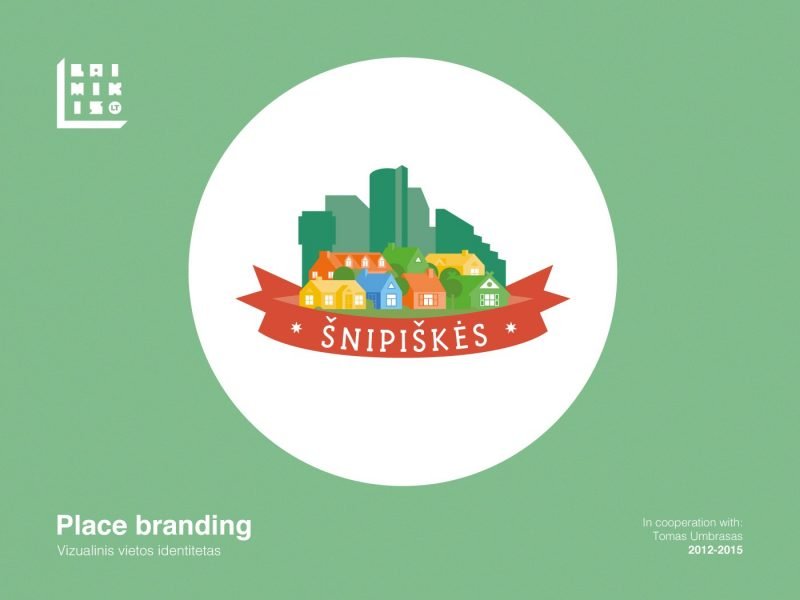
Seeking to re-examine a traditional stereotype of the Šnipiškės neighbourhood as of a slum, a visual identity was developed. An unique architecture contrast between the inhabited wooden houses of 19th century and modern skyscrapers is a core idea of the logo. It is supported by the idea of the neighbourship and recreational values of the neighbourhood. It embraces visual communication of the growing activities in the neighbourhood. More at Behance
Vizualinis identitetas buvo išvystytas siekiant tęstinių iniciatyvų metų pakeisti medinių Šnipiškių kaip lūšnyno, kurio sklypai skirti vien naujų namų statyboms, įvaizdį. Rajonas turi turtingą istoriją, o šiuo metu išsiskiria puoselėjimo vertu unikaliu kontrastu tarp medinės ir modernios architektūros. Tai buvo sukurto logotipo centrinė idėja, papildyta nuoroda į glaudžia medinukų gyventojų kaimynystę ir rajono rekreacinį potencialą.
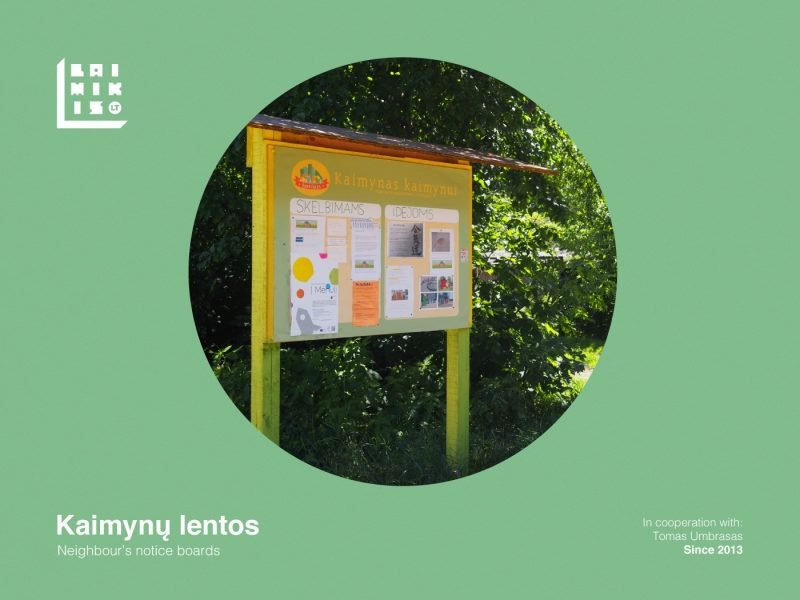
• Notice boards in the neighbourhood’s hotsports were arranged (in one case – renewed) alongside with facebook group for the Šnipiškės residents. A combination of online and offline tools is one of the main principles Laimikis.lt urban group uses in developing local urban networs. The content is fully run by the residents.
• Intensyvių srautų vietose įrengiamos Kaimynų lentos. Tęsdami Gatvės blogo tradicijas, siūlėme kaimynams diskusijas, o taip pat palaikėme jungtį su tuo pat metu atidaryta facebook grupe “Šnipiškiečiai”, laikydamiesi ne kartą išbandyto “online-offline” principo.
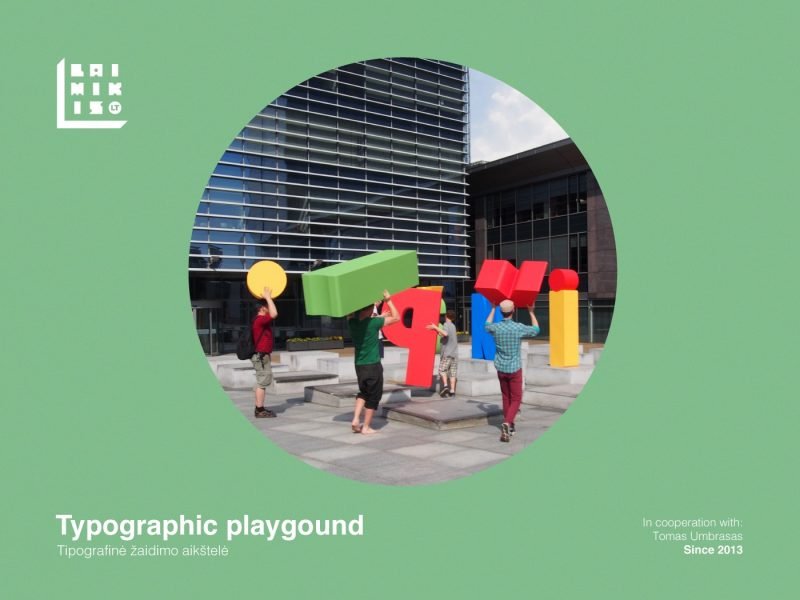
• Street mosaic workshops are an open initiative supported by people of the neighbourhood who donate ceramic tiles and take part in creating collective mosaic artworks. In just a month, two streets of Šnipiškės were touched by mosaics, creating a Mosaic Route in the neighbourhood. It is not by chance that the Street mosaic workshop was set here: Šnipiškės neighbourhood was well-known for its ceramic tiles workshops in the 17th and 18th centuries. In 2013 we arranged learning session in mosaic as a community art tool for Caucasus communities leaders, and now mosaic workshops are launched in more than 10 towns in the Caucasus region!
• Gatvės mozaikos dirbtuvės – atvira bendruomeninio meno iniciatyva, kuri suteikia galimybę kaimynystės gyventojams įsitraukti į savo aplinkos kurimą. Jos pagrindu formuojasi pasitikėjimo tinklai ir spontaniško susitikimo vietos – žmonės mato vieni kitus viešosiose erdvėse, ir patys formuoja naujus traukos centrus. Ši bendruomeninio meno idėja kilo iš paties rajono istorijos – 17 a. Šnipiškės garsėjo keramikos dirbtuvėmis. Mozaikos dirbtuvių metu buvo išvystytas Mozaikos maršrutas. 2013 metais Šnipiškėse organizavome ir Kaukazo šalyse veikiančių bendruomenių lyderių mokymus, pristatydami šį metodą (projekto Caucult rėmuose). Po jų analogiškos mozaikos dirbtuvės buvo organizuotos ir 10 Kaukazo šalių miesteliuose! Daugiau apie bendruomeninio meno reikšmę vystant vietovę: interviu “Tips and thoughts about community art method”.

• Tin garages was a part of soviet cityscape. In Šnipiškės garage subculture was developed in previous times. With a permission of the garage owners Street art gallery initiative was launched. By inviting street artists from Lithuanian cities to reflect upon the specific topics and issues of the neighbourhood, it was sought to create new points of attraction in the neighbourhoods.
• Skardiniai garažai kaip sovietmečio kultūros dalis šiuo metu jau atrodo kaip dėmesio verta egzotika – turtingos faktūros, nublukusios spalvos, ir visa tai dangoraižių fone. Šnipiškių garažų šeimininkų pritarimu dalį garažų pavertėme gatvės meno galerija. Idėja – sukviesti Lietuvos gatvės menininkus, kurie susipažintų su mdeinėmis Šnipiškėmis ir dedikuotų šiam unikaliam rajonui savo autorinį darbą.
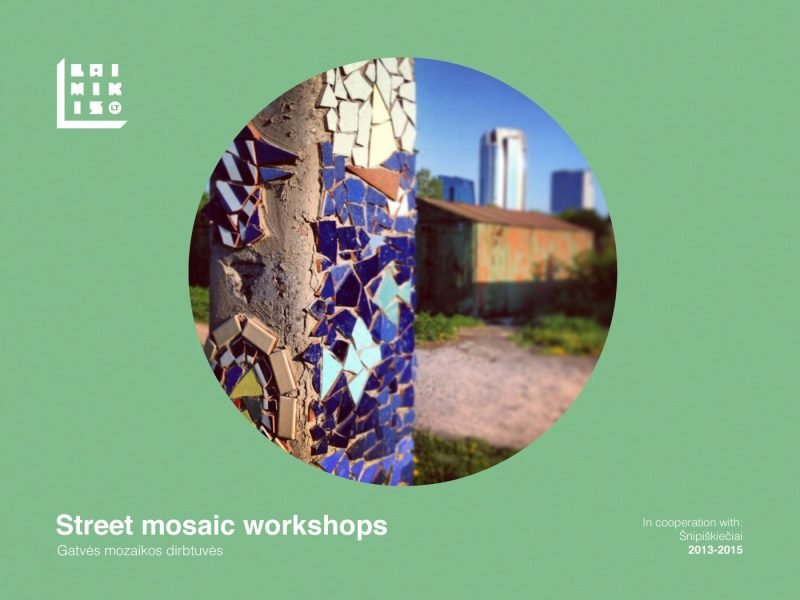
• Traditional lifestyle and rich historical background of the neighbourhood are worth exploring under the guidance of local residents or Laimikis team members. Each resident gains specific knowledge about the neighbourhood. Informal and educational guided tours are run through the year for small groups of visitors in Lithuanian, English and Russian languages.
More info: Šnipiškiečiai facebook.
• Tradicinis gyvenimo būdas ir turtinga kaimynystės istorija yra vertas vilniečių ir Vilniaus svečių dėmesio. Todėl nuo 2012 Šnipiškėse organizuojamos neformalios ekskursijos. Pažintines ekskursijas užsienio ir Lietuvos specialistams ir studentams organizuoja miesto antropologė Jekaterina Lavrinec. Vokietijos istorijos, antropologijos ir politinių mokslų studentai ir jų profesoriai, Nyderlandų architektūros studentai ir jų profesoriai, tarpdisciplininės grupės etnografų ir etnografinių muziejų darbuotojų, kaimynijų vystymo ir neformalaus ugdymo programų specialistus iš įvairių pasaulio miestų (Paryžius, Berlynas, Lisabona, Barselona, Londonas, Briuselis, ir t.t.). Nuo 2014 metų ekskursijas pradėjo vesti ir šnipiškietė Astos Nazarovienės.
Kontaktai:
Jekaterina Lavrinec: Jekaterina.Lavrinec@gmail.com
Asta Nazarovienė: astanazaroviene@gmail.com
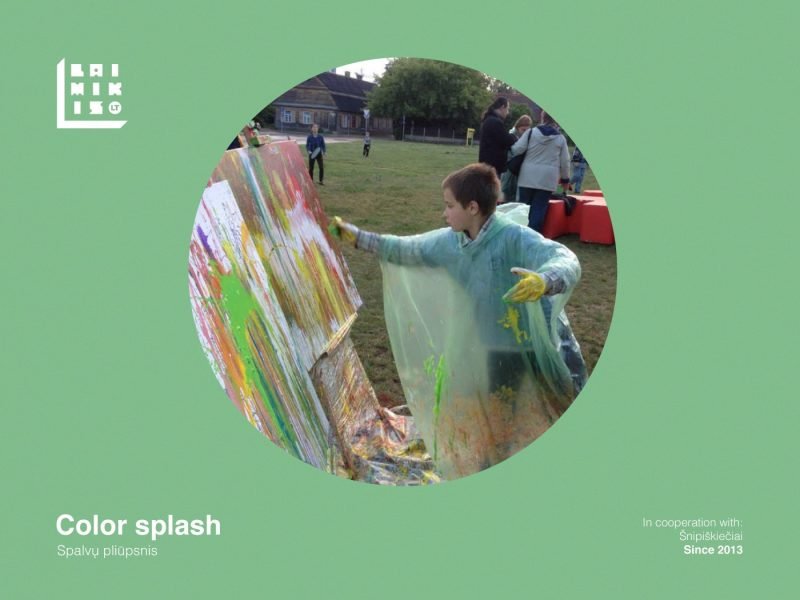
• Typographic placemaking set was produced as multifunctional urban furniture. Used for the residents gatherings and kids’ games, it also serves as a landmark. The main challenge was to create stable type and sustainable yet light modules. This multifunctional urban furniture set is part of a toolbox developed for the cultural regeneration of the wooden Šnipiškės neighbourhood (Vilnius) in 2o12.
Design, special Šnipiškės type: Tomas Umbrasas
Concept, technical solution: Jekaterina Lavrinec + Julius Narkūnas. Laimikis.lt urban co-design group (c).
• Tipografinis vietodaros:) rinkinys tarnauja kaip daugiafunkciniai miesto baldai, skirti gyventojų susirinkimams ir vaikų žaidimams. Bet taip pat raidės tarnauja ir kaip vietos ženklas – nors tai jau yra įprasta didelių raidžių funkcija.
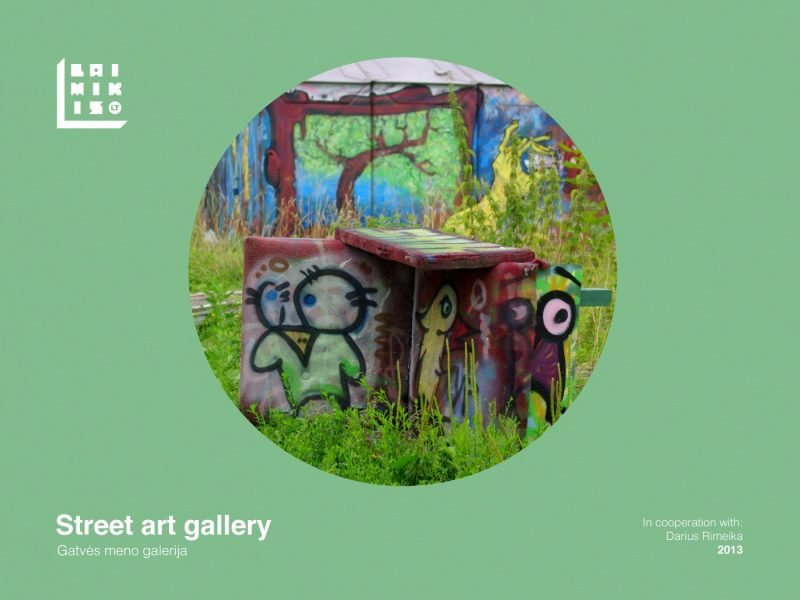
Informal neighbours gatherings help to develop a public space in the neighbourhood and to expant a network of local contacts. Now the initiative of neighbours gatherings is fully run by the local residents.
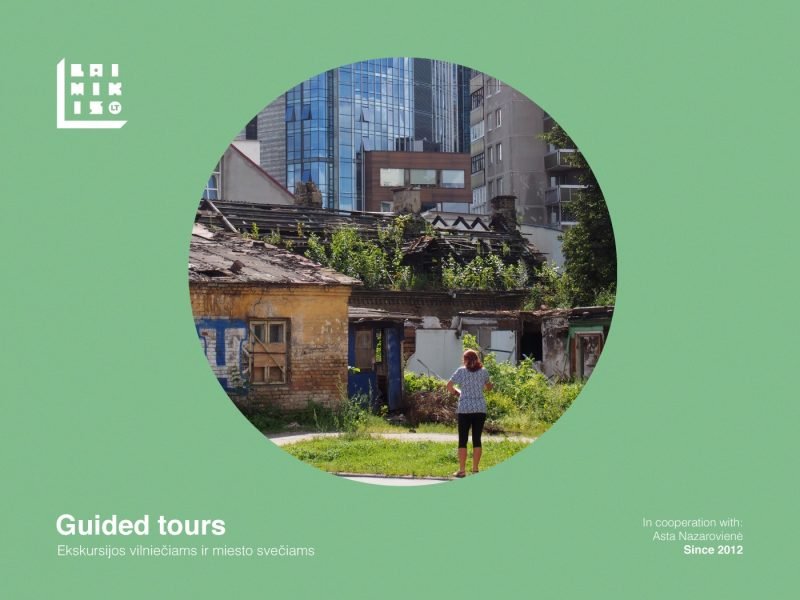
Color splash is a collective painting, based on the techniques of abstract expressionism. By arranging this activity in public space we treat every participant as an artist or as a critic, asking passers-by to comment on the result.
More: https://laimikis.lt/photojam-color-splash/

• Urbingo is an urban orientation game and alternative guide to the changing neighbourhoods. Laimikis.lt has developed this game as a matrix for collecting and arranging neighbourhood stories and changing material culture, turning it into actively used archive. It is a tool for activating the interest in the rapidly changing neighbourhoods and their stories, and encouraging citizen participation in gathering the valuable empirical data on the material culture of the changing neighbourhood. It consists of: illustrated map, visual cards with the neighbourhood’s elements, text cards with notes and historical facts. We run this game periodically in spring and summer time: Facebook Urbingo.
Design and illustration: Tomas Umbrasas
Idea, photography and texts: Jekaterina Lavrinec + Julius Narkūnas. Laimikis.lt urban co-design group (c).
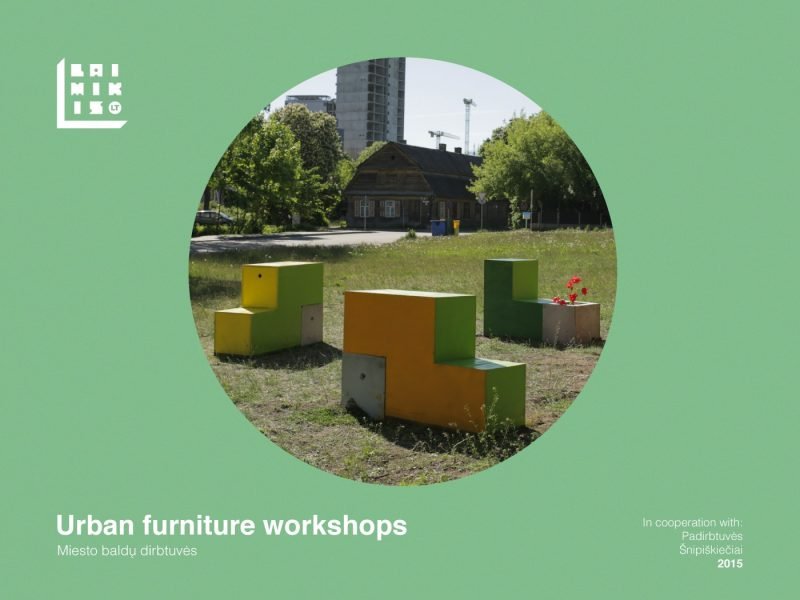
A tetris-like urban furniture set is adaptive to the needs of different neighbourhoods.
Designed in cooperation with makers space Padirbtuvės and arranged with a great help of the local residents.
Schemes: http://issuu.com/laimikislt/docs/miesto_baldai_leidinys_a4_copy
Documentation: https://www.youtube.com/watch?v=M3Y0-fgmStA

